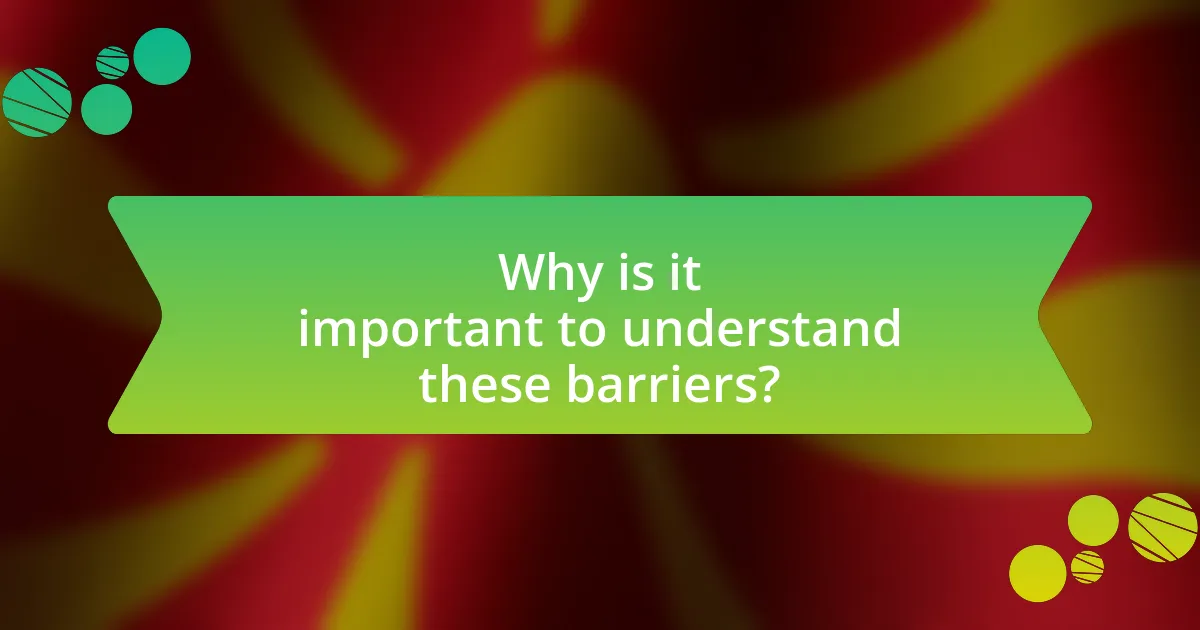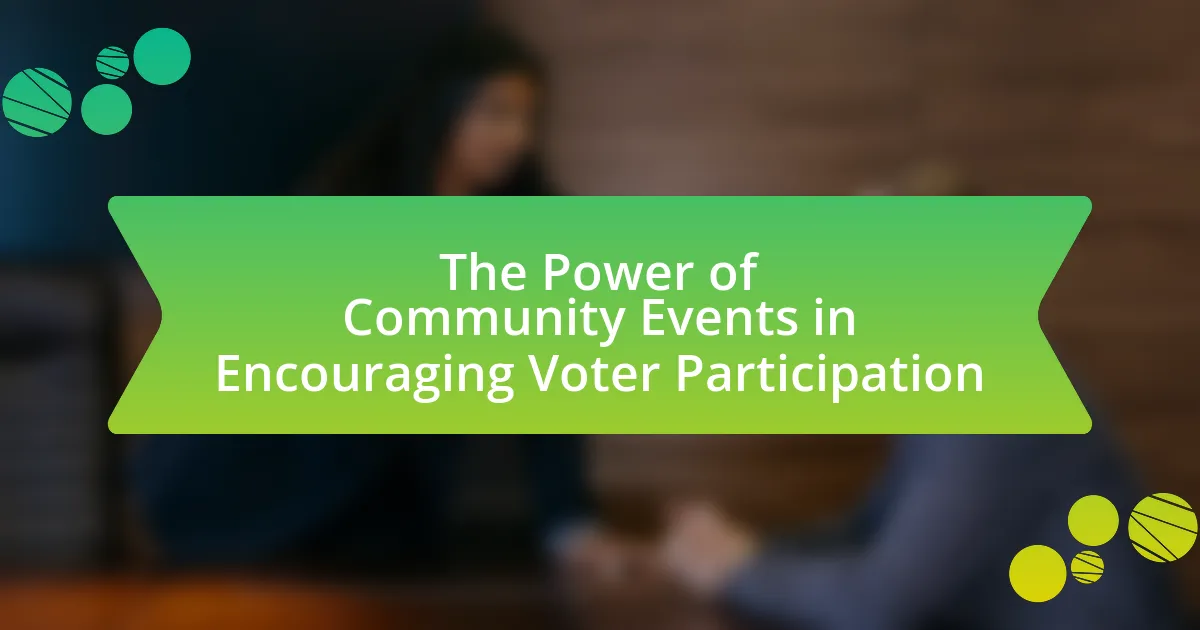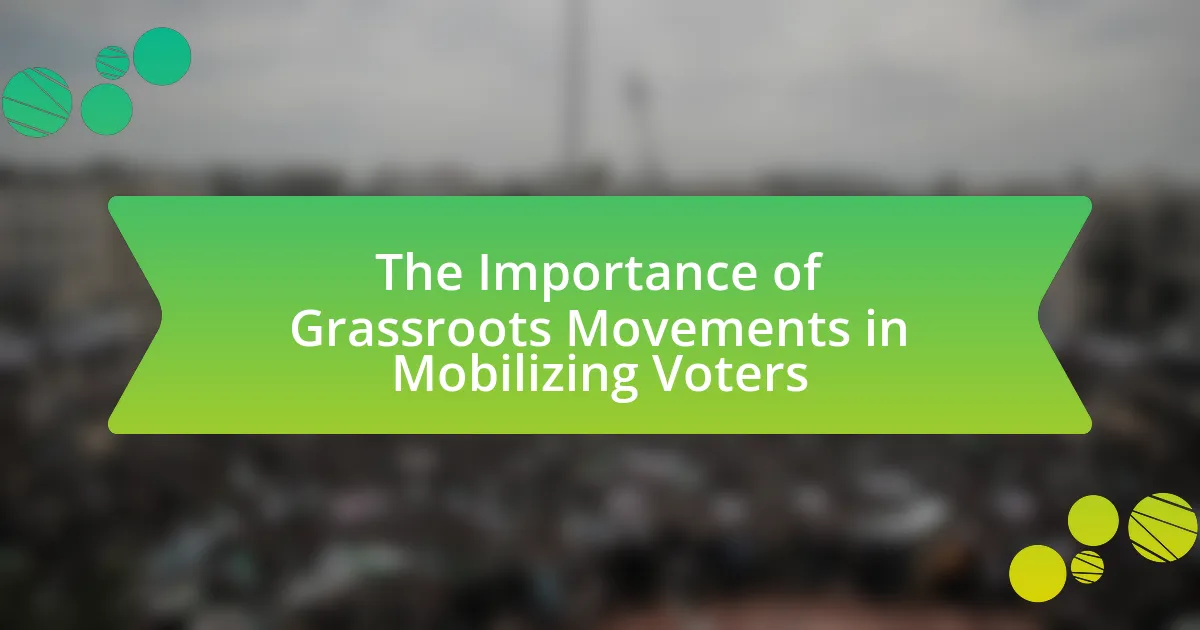The article focuses on understanding the barriers to voting and strategies to overcome them. It identifies key obstacles such as voter ID laws, socioeconomic factors, misinformation, and logistical challenges that disproportionately affect marginalized groups. The discussion includes the impact of income and education on voter participation, legal barriers like felony disenfranchisement, and the importance of accessibility at polling places. Additionally, it outlines potential solutions, including legislative reforms, community engagement, and grassroots campaigns aimed at enhancing voter turnout and ensuring equitable access to the electoral process.

What are the main barriers to voting?
The main barriers to voting include voter ID laws, lack of access to polling places, and misinformation about the voting process. Voter ID laws can disproportionately affect marginalized groups who may not have the required identification. Additionally, inadequate polling locations can lead to long wait times and discourage participation, particularly in low-income areas. Misinformation, often spread through social media, can confuse voters about registration deadlines and voting procedures, further hindering turnout. According to the U.S. Census Bureau, in the 2020 election, approximately 25% of eligible voters cited difficulties with the voting process as a reason for not voting.
How do socioeconomic factors impact voter participation?
Socioeconomic factors significantly impact voter participation by influencing individuals’ access to resources, education, and civic engagement opportunities. For instance, individuals with higher income levels are more likely to vote, as they often have greater access to transportation, time off work, and information about the voting process. According to the U.S. Census Bureau, in the 2020 election, 79% of individuals with a bachelor’s degree voted, compared to only 48% of those without a high school diploma. This disparity illustrates how education, a key socioeconomic factor, correlates with higher voter turnout. Additionally, marginalized communities often face systemic barriers such as voter ID laws and limited polling locations, further decreasing their participation rates.
What role does income level play in voting accessibility?
Income level significantly impacts voting accessibility, as individuals with lower incomes often face more barriers to participating in elections. Research indicates that lower-income voters may struggle with transportation costs, time off work, and access to polling places, which can lead to decreased voter turnout. For instance, a study by the U.S. Census Bureau found that in the 2020 election, only 50% of eligible voters with incomes below $30,000 participated, compared to 80% of those earning over $100,000. This disparity highlights how income level directly correlates with the ability to vote, emphasizing the need for targeted policies to enhance accessibility for economically disadvantaged populations.
How does education influence voter turnout?
Education significantly influences voter turnout by increasing individuals’ political knowledge and engagement. Higher levels of education correlate with greater awareness of political issues, voting processes, and the importance of participation in elections. For instance, research from the U.S. Census Bureau indicates that in the 2020 presidential election, 79% of individuals with a bachelor’s degree voted, compared to only 48% of those without a high school diploma. This disparity highlights how education equips voters with the skills and confidence necessary to navigate the electoral system, ultimately leading to higher turnout rates.
What legal barriers exist that hinder voting?
Legal barriers that hinder voting include voter ID laws, felony disenfranchisement, and restrictive registration requirements. Voter ID laws require individuals to present specific forms of identification, which can disproportionately affect minority and low-income populations who may lack such IDs. Felony disenfranchisement laws prevent individuals with felony convictions from voting, impacting millions; for instance, in 2020, approximately 5.2 million Americans were unable to vote due to such laws. Additionally, restrictive registration requirements, such as limited registration periods and complicated processes, can deter eligible voters from participating in elections. These barriers collectively contribute to lower voter turnout and unequal access to the electoral process.
How do voter ID laws affect different demographics?
Voter ID laws disproportionately affect marginalized demographics, particularly racial minorities, low-income individuals, and the elderly. Research indicates that these groups are less likely to possess the required forms of identification, which can lead to decreased voter turnout. For instance, a study by the Brennan Center for Justice found that approximately 25% of eligible voters in the U.S. do not have government-issued photo ID, with higher percentages among African American and Latino voters. Additionally, low-income individuals often face barriers in obtaining IDs due to costs and accessibility issues, while elderly voters may struggle with mobility and documentation requirements. These factors collectively contribute to systemic disenfranchisement, highlighting the need for policies that ensure equitable access to voting.
What are the implications of felon disenfranchisement?
Felon disenfranchisement significantly impacts democratic participation and social equity. When individuals with felony convictions lose their voting rights, it reduces their ability to influence policies that affect their lives, perpetuating cycles of marginalization. According to the Sentencing Project, approximately 5.2 million Americans were disenfranchised due to felony convictions as of 2020, disproportionately affecting communities of color. This disenfranchisement can lead to underrepresentation in political processes, resulting in policies that do not address the needs of these communities. Furthermore, studies indicate that restoring voting rights can improve reintegration outcomes for formerly incarcerated individuals, fostering a sense of civic responsibility and community engagement.
How do logistical challenges affect voter turnout?
Logistical challenges significantly reduce voter turnout by creating barriers that hinder access to polling places. For instance, long wait times, inadequate transportation options, and limited polling hours can discourage individuals from voting. A study by the U.S. Election Assistance Commission found that 25% of voters cited long lines as a reason for not voting in the 2016 election. Additionally, areas with fewer polling locations often experience higher rates of disenfranchisement, as seen in urban neighborhoods where residents may have to travel further to cast their ballots. These logistical issues directly correlate with decreased participation rates, highlighting the importance of addressing them to improve voter turnout.
What transportation issues do voters face on election day?
Voters face several transportation issues on election day, primarily including limited public transit options, long travel distances to polling places, and traffic congestion. Limited public transit can restrict access for individuals without personal vehicles, particularly in rural areas where polling locations may be far from residential neighborhoods. According to the U.S. Census Bureau, approximately 5% of Americans do not have access to a vehicle, which can significantly hinder their ability to vote. Additionally, long travel distances can discourage voters, especially those with mobility challenges or time constraints. Traffic congestion in urban areas can further exacerbate these issues, leading to delays that may prevent voters from reaching polling places before they close.
How does polling place accessibility impact voter participation?
Polling place accessibility significantly impacts voter participation by directly influencing individuals’ ability to reach and utilize voting facilities. Research indicates that when polling places are accessible, including features such as ramps, adequate signage, and transportation options, voter turnout increases. For instance, a study by the U.S. Government Accountability Office found that jurisdictions with accessible polling places saw a 10% higher turnout among individuals with disabilities compared to those without such accommodations. This demonstrates that improved accessibility not only facilitates participation for those with mobility challenges but also encourages broader community engagement in the electoral process.

Why is it important to understand these barriers?
Understanding the barriers to voting is crucial because it enables the identification and mitigation of obstacles that prevent individuals from exercising their democratic rights. By recognizing these barriers, such as socioeconomic factors, lack of access to information, and systemic discrimination, policymakers and advocacy groups can implement targeted strategies to enhance voter participation. Research indicates that in the 2020 U.S. elections, approximately 4 million eligible voters did not participate due to accessibility issues, highlighting the need for informed interventions. Addressing these barriers not only promotes equity in the electoral process but also strengthens the overall democratic system by ensuring that all voices are heard and represented.
How do barriers to voting affect democracy?
Barriers to voting undermine democracy by disenfranchising segments of the population, leading to unequal representation. When individuals face obstacles such as strict voter ID laws, limited polling places, or complicated registration processes, their ability to participate in elections diminishes. For instance, a study by the Brennan Center for Justice found that states with strict voter ID laws saw a decrease in voter turnout, particularly among minority and low-income groups. This disenfranchisement results in a skewed electoral process where the voices of certain demographics are marginalized, ultimately weakening the democratic principle of equal representation for all citizens.
What is the relationship between voter turnout and election outcomes?
Voter turnout significantly influences election outcomes, as higher participation rates often correlate with the success of candidates who appeal to a broader electorate. For instance, in the 2008 U.S. presidential election, voter turnout reached approximately 61.6%, leading to a decisive victory for Barack Obama, who garnered support from diverse demographic groups. Conversely, lower turnout can favor candidates with strong support among their base, as seen in the 2014 midterm elections, where turnout was around 36.4%, benefiting Republican candidates. This relationship underscores the importance of mobilizing voters to ensure representative outcomes in elections.
How do disenfranchised groups influence policy decisions?
Disenfranchised groups influence policy decisions primarily through advocacy, grassroots mobilization, and coalition-building. These groups often organize campaigns to raise awareness about their specific needs and challenges, which can lead to increased public pressure on policymakers. For instance, the Civil Rights Movement in the 1960s, driven by disenfranchised African Americans, resulted in significant legislative changes such as the Voting Rights Act of 1965, which aimed to eliminate barriers to voting. Additionally, research shows that when disenfranchised communities engage in protests or lobbying efforts, they can shift public opinion and compel legislators to address their concerns, thereby impacting policy outcomes.
What are the consequences of low voter participation?
Low voter participation leads to weakened democratic processes and underrepresentation of diverse populations. When fewer individuals engage in elections, the elected officials may not reflect the views and needs of the entire community, resulting in policies that favor specific groups over the general populace. For instance, the U.S. Census Bureau reported that in the 2020 presidential election, only about 66.8% of the eligible voting population participated, which can skew policy decisions and resource allocation. Additionally, low turnout can diminish the legitimacy of elected officials, as they may be chosen by a minority of the electorate, undermining public trust in the political system.
How does low turnout affect representation in government?
Low turnout negatively affects representation in government by skewing electoral outcomes and diminishing the legitimacy of elected officials. When fewer citizens participate in elections, the elected representatives may not accurately reflect the preferences and needs of the broader population. For instance, in the 2016 U.S. presidential election, approximately 60% of eligible voters cast ballots, leading to a situation where the elected president won with the support of only about 25% of the eligible electorate. This disparity can result in policies that favor the interests of a smaller, more homogeneous group rather than the diverse views of the entire electorate, ultimately undermining democratic principles and accountability.
What are the long-term effects on civic engagement?
Long-term effects on civic engagement include increased political participation, enhanced community cohesion, and improved public policy outcomes. Research indicates that sustained civic engagement fosters a habit of voting and active involvement in local governance, leading to higher turnout rates in elections. For instance, a study by the National Conference on Citizenship found that individuals who engage in civic activities are 20% more likely to vote in subsequent elections. Additionally, communities with high levels of civic engagement often experience stronger social networks, which can lead to more effective advocacy for public services and policies that reflect the needs of residents.

What strategies can be implemented to overcome voting barriers?
To overcome voting barriers, strategies such as implementing automatic voter registration, expanding early voting, and enhancing accessibility for individuals with disabilities can be employed. Automatic voter registration simplifies the process by registering eligible citizens when they interact with government agencies, which can increase participation rates. Expanding early voting provides more opportunities for individuals to cast their ballots, accommodating those with rigid work schedules or personal commitments. Additionally, enhancing accessibility, such as providing resources in multiple languages and ensuring polling places are physically accessible, addresses the needs of diverse populations. These strategies have been shown to improve voter turnout and engagement, as evidenced by studies indicating that states with automatic registration and extended voting periods experience higher participation rates.
How can community organizations help increase voter turnout?
Community organizations can help increase voter turnout by implementing targeted outreach programs that educate and mobilize voters. These organizations often engage in door-to-door canvassing, phone banking, and community events to raise awareness about the importance of voting and provide information on registration and polling locations. For instance, a study by the National Bureau of Economic Research found that grassroots mobilization efforts can increase voter turnout by as much as 10%. Additionally, community organizations can address specific barriers to voting, such as transportation issues or language barriers, by offering resources like rides to polling places or multilingual materials.
What role do grassroots campaigns play in voter education?
Grassroots campaigns play a crucial role in voter education by directly engaging communities and providing accessible information about the voting process. These campaigns often utilize local volunteers who understand the specific needs and concerns of their communities, making the information more relatable and effective. For instance, according to a study by the Pew Research Center, grassroots efforts can increase voter turnout by as much as 10% by educating voters on registration deadlines, polling locations, and voting rights. This localized approach not only informs voters but also empowers them to participate in the electoral process, thereby addressing barriers to voting such as misinformation and lack of awareness.
How can partnerships with local businesses enhance voter access?
Partnerships with local businesses can enhance voter access by providing convenient locations for voter registration and polling places. For example, businesses can host voter registration drives, making it easier for community members to register while they shop or dine. Additionally, local businesses can offer incentives, such as discounts or promotions, to encourage customers to participate in elections. Research indicates that community engagement initiatives, including those involving local businesses, significantly increase voter turnout; a study by the National Bureau of Economic Research found that targeted outreach in local settings can boost participation rates by up to 10%. Thus, collaboration with local businesses effectively removes barriers to voting by increasing accessibility and motivation.
What legislative changes can improve voting accessibility?
Legislative changes that can improve voting accessibility include implementing automatic voter registration, expanding early voting periods, and mandating the availability of accessible voting machines. Automatic voter registration can increase participation by simplifying the registration process, as evidenced by states like California, which saw a 20% increase in voter registration after its implementation. Expanding early voting periods allows more individuals to vote at their convenience, reducing long lines and wait times, as demonstrated in states like Texas, where early voting led to a 30% increase in turnout. Mandating accessible voting machines ensures that individuals with disabilities can cast their votes independently and privately, aligning with the Americans with Disabilities Act, which requires equal access to public services.
How can reforms to voter ID laws promote inclusivity?
Reforms to voter ID laws can promote inclusivity by reducing barriers that disproportionately affect marginalized groups. For instance, implementing measures such as allowing alternative forms of identification, providing free IDs, and expanding access to ID acquisition can help ensure that individuals without traditional identification, often from low-income or minority backgrounds, can participate in elections. Research from the Brennan Center for Justice indicates that strict voter ID laws can lead to disenfranchisement, particularly among communities of color, where studies show that up to 25% of eligible voters may lack the required ID. By reforming these laws to be more flexible and accessible, states can enhance voter participation and ensure that all citizens have an equal opportunity to exercise their right to vote.
What measures can be taken to simplify the registration process?
To simplify the registration process, implementing online registration systems is essential. Online registration allows users to complete their applications conveniently from any location, reducing the need for physical paperwork and in-person visits. According to the National Association of Secretaries of State, states that offer online registration have seen increased participation rates, as it streamlines the process and makes it more accessible. Additionally, simplifying the required documentation and providing clear instructions can further enhance user experience, ensuring that individuals understand what is needed to register successfully.
What practical steps can individuals take to support voting rights?
Individuals can support voting rights by actively participating in voter registration drives and advocating for accessible voting options. Engaging in local organizations that focus on voting rights, such as the League of Women Voters, can help raise awareness and mobilize efforts to eliminate barriers. Additionally, individuals can educate themselves and others about voting laws and changes, ensuring that communities are informed about their rights. Supporting legislation that protects voting rights, such as the John Lewis Voting Rights Advancement Act, further strengthens these efforts. According to the Brennan Center for Justice, states with more accessible voting laws see higher voter turnout, demonstrating the impact of these actions.
How can citizens advocate for policy changes in their communities?
Citizens can advocate for policy changes in their communities by organizing grassroots campaigns, engaging in local government meetings, and utilizing social media platforms to raise awareness. Grassroots campaigns mobilize community members to collectively voice their concerns and propose solutions, which can influence local policymakers. Participation in local government meetings allows citizens to directly communicate their needs and priorities to elected officials. Additionally, social media serves as a powerful tool for spreading information, gathering support, and fostering discussions around specific policy issues, thereby amplifying the citizens’ voices. These methods have been shown to effectively impact policy decisions, as evidenced by numerous successful community-led initiatives across various regions.
What resources are available for educating others about voting rights?
Resources available for educating others about voting rights include organizations, websites, and educational materials. Notable organizations such as the American Civil Liberties Union (ACLU) and the League of Women Voters provide comprehensive information and advocacy tools. Websites like Vote.org and CanIVote.org offer resources on voter registration, polling locations, and voting procedures. Educational materials, including pamphlets and online courses, are also available through these organizations to raise awareness about voting rights and the importance of participation in elections.





